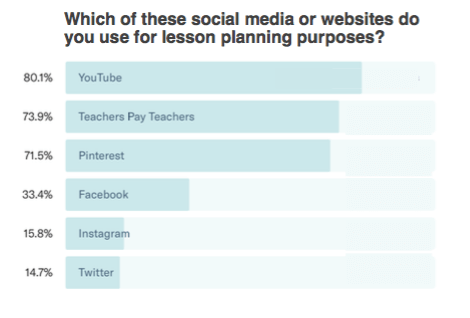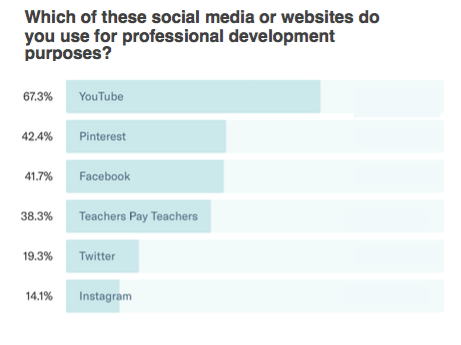2019 State of Teaching Survey Results
7 Min Read • Research
In December of 2018, EducationCloset offered teachers the ability to take a survey reflecting their current state of teaching. In this report, we’re sharing the results from that survey.
WHO WE SURVEYED
Over 5,000 teachers responded to this survey. They spanned from grades PreK-Post Secondary with the largest group of respondents being elementary school teachers at 58.5%, followed by middle school teachers at 20.5%.
Our organization specializes in arts integration and STEAM, which is reflected in the respondents who took this survey. About 34% were arts teachers, followed closely by general classroom teachers at 30.5%. 15.4% identified themselves as STEM teachers.
Based on our survey, there are quite a few veterans in the field of teaching. Over 36% had 20+ years of experience. Only 18% are new teachers who have taught for less than 6 years.
CURRICULUM AND PLANNING
Curriculum (what is being taught) and preparation time are key elements that drive instruction in schools. Here’s a snapshot of what is common for teachers in this area.
Prescribed Curriculum
A little over half of teachers surveyed have a prescribed curriculum from their school or district. That said, over 45% of teachers are working without a prescribed curriculum and need to develop or source their own lessons or resources.

Time Spent Planning
The majority of our respondents say they spend between 1-10 hours planning lessons per week. About 16% say they spend 11-20 hours and only 4% spend more than 20 hours per week planning.

Common Planning is Common
Collaborative planning is more common than not. Almost 60% of respondents say they have opportunities to collaboratively plan with other teachers. 40% of teachers are planning on their own or with limited time for meeting with other teachers.
Curriculum Standards
A large majority of teachers feel confident in their knowledge and use of curriculum standards. Over 86% of teachers identified that the know where to find and how to use their own standards.
Not Enough Time
According to our respondents, there’s not enough time to get their work done during the school day. 90% of teachers say they take work home after school.
THE RISE OF SOCIAL MEDIA
Social media is playing an important role in the everyday work of teachers. Here’s how they are using these tools for educational purposes.
Teaching or Lesson Supplement
The mass majority of teachers use social media and websites to supplement their teaching or lessons. With a whopping 94.2% using these tools for teaching or lesson planning, teachers are using digital media more than ever.

YouTube Wins Big
Over 80% of teachers surveyed shared they use YouTube for lesson planning and 67% of them use the video tool for professional development. For lesson planning, Teachers Pay Teachers and Pinterest are almost even in usage, followed by Facebook, Instagram and Twitter. Professional development shakes out a little differently with Pinterest and Facebook tying for PD, followed by Teachers Pay Teachers, Twitter and Instagram.

INCOME SUPPLEMENT
In 2018, the discussion over low teacher pay came into the spotlight yet again. We asked survey participants if they have a 2nd job to supplement their income.
Surprisingly, almost 65% said no with only 35% saying they hold another job in addition to teaching. It should be noted we did not ask for personal background information such as if they are in a single or dual income household.
Those who do hold a second job for additional income work in a variety of capacities including in retail, tutoring, babysitting, artists or musicians, selling lessons on TpT, coaching and the service industry.
WHAT’S NEXT?
In this section, we asked teachers about support for their work and their concerns, as well as future plans.
Feeling Supported?
Over 71% of our respondents say they feel supported by their supervisor in their current position. Interestingly, when asked what would help them stay in education longer, almost 50% shared comments that in some way indicated more support from administration or the community.
Concerns for this Year
When asked about their biggest concerns for 2019, teachers in this survey were tied in their top 3 responses: classroom management, learning a new initiative and getting through the curriculum. This was followed closely by data collection, professional learning goals and school safety.

Plans to Stay or Leave
Over 42% of teachers plan to stay in the education profession as long as possible. About 28% indicate they will stay another 1-5 years and 25% say they will stay for 6-10 more years. Only 4.3% indicate plans to leave within a year.

What would Help You Stay?
For our final question, we asked teachers what would help them stay in education longer. Over 75% responded with the word “money”, but there was a wide context for this term. Some teachers indicated higher pay, while others shared more money for training, materials or supplemental programs.
Additionally, 25% ask for more support and respect from parents and community members. While 50% stated they’d like more support from administration, that also was provided with a variety of contexts. Some shared they wanted more support from administration for behavioral interventions, others shared the need for their administrators to provide flexibility, more relevant and personalized professional development options and providing materials and resources for staff.
Here are some examples of responses received:
“A real raise. For the last 25 years (I’m in my 29th year of teaching), we have gotten a 2% raise. I watch people in other fields that require similar education/training and work load get 10% or more each year. They are aghast when I tell them that my raise will yet again NOT cover the increase in health insurance premium. They cannot understand why I continually take essentially less pay for the work I do.”
“I would stay in education longer if it wasn’t so draining. After putting in ten to twelve hour days, I am ready for a break, but I still come home and have work there It takes a toll on a body. The students in my Title 1 school need so much. They need help academically, emotionally, and physically. Due to their lack of socially acceptable behavior, there are days I have been concerned about my physical safety.”
“Administrative support, a better schedule, less demands, more time, opportunities to collaborate with my team”
“If it was more important to educate whole, happy children, to be the best that they can be, rather than be required to squeeze unique, individual, creative beings into consumerism and profit lead, drones! We teach little humans not chunks of performing data producing units!”
“I need the materials to teach like paper, pencils, chart paper, textbooks, less tests or more relevant ones that will actually guide and “drive” my instruction. I need time to teach what is most important academically. I need smaller class sizes so that I can meet the needs of my students. I need more collaboration time and social services support. I need to be allowed to teach and integrate the arts into my curriculum more often without worrying about if my supervisor will deem it academically necessary. More than anything, I need parental support. We are a team and need to work together.”
SUMMARY OF KEY FINDINGS
As we reviewed this data, there were some large ideas that rose to the surface. First, teachers in general are overworked. From taking work home to searching for additional resources and in some cases taking on a 2nd job to help make ends meet, it’s clear that teachers lack the time and resources required to do meet their responsibilities.
On the positive side, teachers do have access to curriculum, planning time and feel confident in their standards. These are all research-backed indicators for successful instructional outcomes.
Additionally, social media is playing a much bigger role in instruction and is causing a shift in the teaching profession. Video as a medium is providing support in both lesson planning and professional development. It will be interesting to see if other social media and website platforms catch up to YouTube as video becomes more prominent on most social media platforms and websites.
Lastly, the written responses and data from this survey indicate that teachers don’t currently feel valued as professionals. Knowing this can help administration, communities and education organizations to consider tools, resources and behaviors that treat educators with respect and value.


